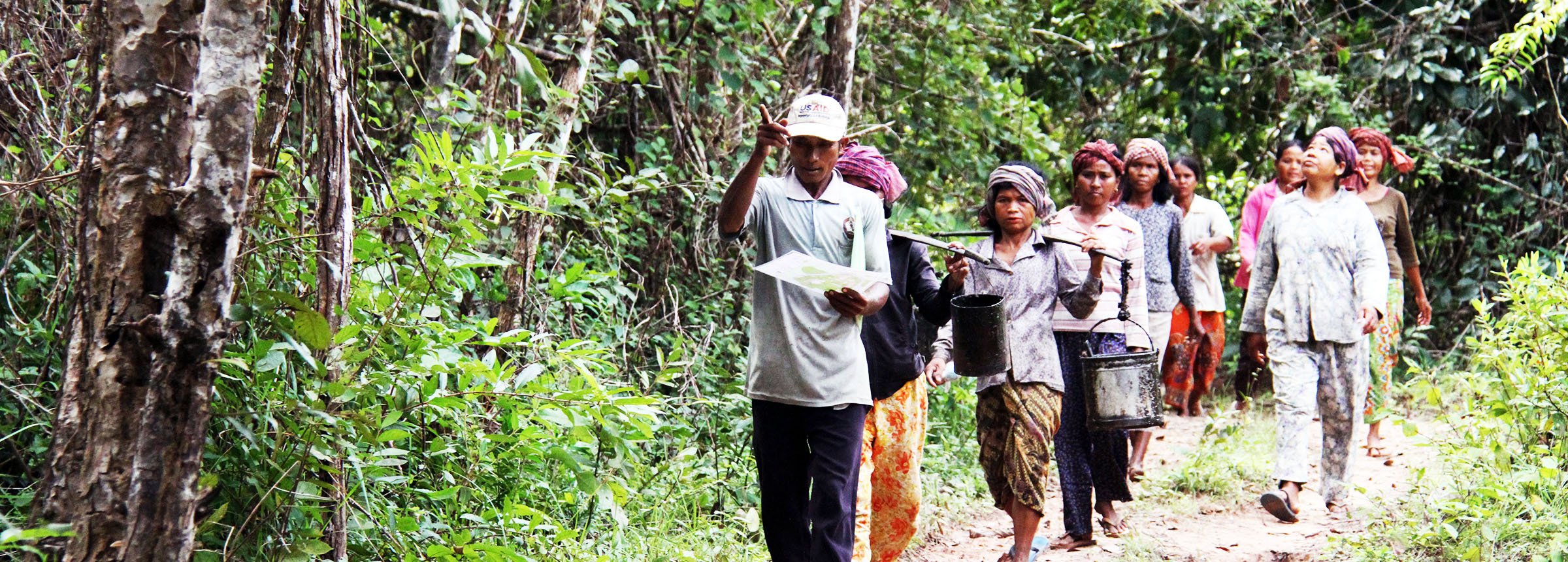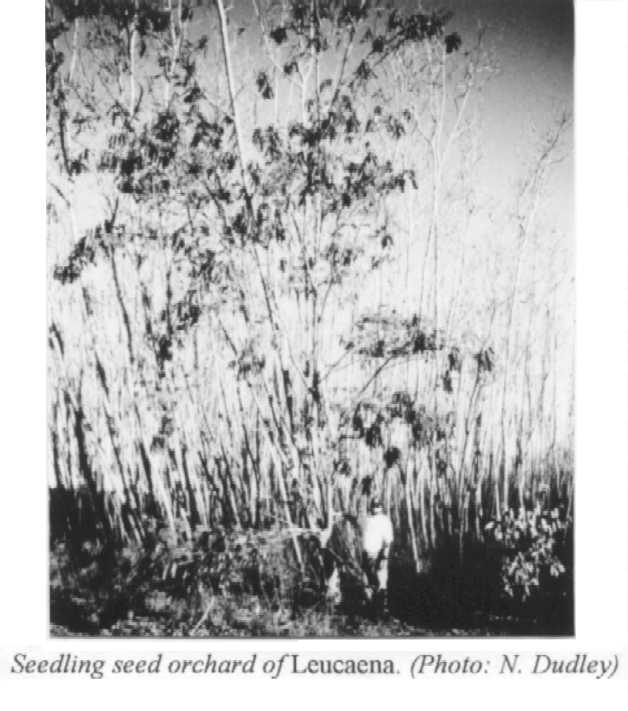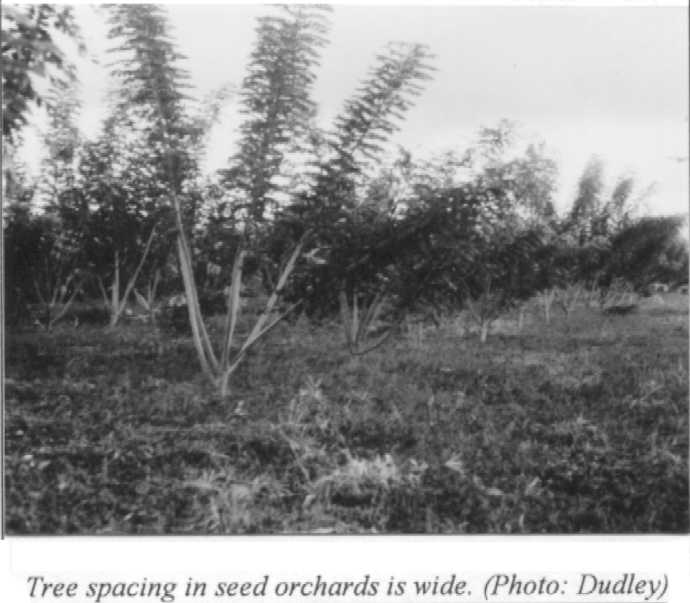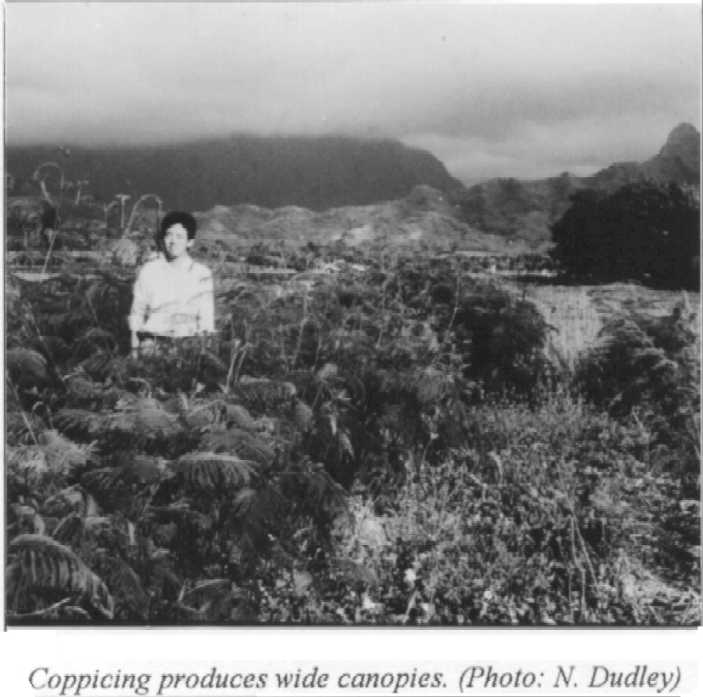
Seed Production Guidelines for Tropical Tree Legumes
Any discussion about tree seed production must consider the adage “garbage in equals garbage out”. If you plant junk seeds you will inevitability harvest junk trees. Junk refers to inferior tree seeds derived mainly from inbreeding, collected from a narrow genetic base and uncontrolled hybridization. Junk also arises from indiscriminate seed collection from non-superior trees.
I. Meeting Short term seed needs
Genetically improved tree seed production is a long term objective. However, when quality tree seed is required for immediate planting, the following guidelines should be observed.
A. Collect seed from superior individual trees from large populations. Caution should be exercised since superior trees could be the result of environmental effects. Do not collect seed from all the trees in a population. The intensity of selection should be approximately 10% or less of the total population, but should consist of a minimum of 25 trees. Do not select heavy seeded trees since these trees put additional energy into producing seeds rather than wood or leaf. Generally, seed collected from superior individual trees from a large population will be adapted to local environmental conditions and tolerant of insects and diseases found locally.
B. Obtain tree seed from proven sources. This is the most common method of obtaining seed quickly. If local testing has identified a superior seed source or provenance that has proven well adapted then this can be very successful. If the original testing and documentation were accurate and the integrity of the seed supplier is not in question, there should be no problems. Bulk collections of undocumented or vaguely defined seed sources should be avoided.
The Oxford Forestry Institute collected 30 Gliricidia sepium provenances that represent a wide range of variation and distributed the seed to over 100 collaborators in the tropics. Subsequent trials identified Retalhuleu (Guatemala) as a superior provenance of G. sepium appropriate for use at many sites. This example illustrates the benefit of using source identified tree seed when large quantities of specific tree species are required.
II. Three Aspects of Seed Production
Genetic diversity should be promoted since a large range in genetic variation is necessary to achieve improvement of tree quality. Without sufficient genetic variability it is difficult to make gains for traits of interest. Any attempt to improve trees from a narrow base will be unsuccessful.
Inbreeding depression results from a high proportion of self-pollination in the breeding population. This must be avoided at all costs since inbreeding confers a lack of fitness or a lack of adaptation.
Hybridization is a cross between two varieties or species. Vigor and fitness are associated with hybridization between superior individuals. What must be avoided is “uncontrolled” hybridization (i.e. contamination from inferior individuals) that dilutes the genetic quality of superior parent trees. For agricultural crops, hybridization is generally between different varieties of the same species. However, in forestry hybridization most often occurs at the species level as interspecific hybridization.
III. Meeting long-term seed needs – Seed orchards
Relatively few organizations are willing or able to make the long term commitment necessary to establish orchards for tree seed production. If the decision is made to establish a seed orchard, a long term plan is very important. Several years of planning are required before the first tree is planted. A number of issues must be considered before establishment. Some relevant issues include: Are there sufficient financial resources and have land tenure issues been resolved? What type of orchard is appropriate for the tree species of interest? Are there locations where tree species will flower early and heavily? Does your organization have the expertise to manage the seed orchard successfully?
A seed orchard is an area where seeds of particularly valuable genotypes are produced to obtain seed as quickly and economically as possible. This is a specialized plantation of selected progenies which are isolated to avoid contamination, and managed to produce frequent, abundant, and easily harvested seed crops. Orchards can be for genetic improvement and production of large quantities of seed for operational planting. Generally, the benefits of orchards are the production of seed with improved disease and insect resistance, growth, wood qualities, adaptability, and tree form.

Seedling seed orchards are plantations with known family identity that are managed for maximum seed production. They consist of a population of open (naturally) pollinated families of selected trees. Often, they are “first generation” orchards that are the result of species and provenance trials. Typically, they result from rouging, a process of removing the trees with less desirable genetic potential. Most multiple purpose tree seed orchards are of this type.
Vegetative orchards are established from vegetative material such as clones, cuttings, grafts, or other asexual methods such as micropropagation. These are the most common operational orchard for large scale seed production. They are categorized as being “advanced generation” orchards where selected parents trees of known pedigrees are utilized. Vegetative orchards are most often associated with industrial forest species such as eucalyptus and pines.
Both types of orchards serve specific needs. The tree species of interest and breeding method will determine which type of orchard is most suitable for seed production requirements.
Site Selection Criteria
An ideal site will have good soil structure, drainage, and fertility, with protection from high winds. Seed orchards also require level or gently sloping terrain with easy access and good security. They should be located near the nursery or farm offices so that equipment and personnel are readily available. This will aid in overall orchard efficiency by reducing travel time to the site. Generally, abandoned agricultural lands make good sites. It is important that site environment characteristics encourage early and heavy flower production. Site requirements differ depending on the tree species of interest.
The distance between the orchard and contaminating foreign pollen is called the pollen dilution zone. The appropriate isolation distance for dilution zones are not well documented for most tropical tree legumes and depends on the mode of pollen transport. A wise approach is to keep as great a distance as possible from the orchard and sources of contamination. Many tree legumes are pollinated by insects. In such cases, a dilution zone of at least 100 in should reduce contamination to an acceptable level.
Seed orchard size depends on seed production objectives. Generally, if average rate of seed production per tree is known, then calculating the number of trees needed to reach the production objective is straight forward. An orchard where insects are controlled and soil fertility is well managed will yield seed of higher quality and quantity then an unmanaged orchard.
 Orchard Establishment and Management
Orchard Establishment and Management
Ripping with a subsoiling implement to eliminate soil compaction should be considered on abandoned agricultural land. Soil pH should always be tested and nutrient levels amended as required to promote growth and flowering. Generally, the elements of importance are nitrogen for growth and phosphorus for flowering. However, a deficiency of any marco or micro-nutrient can effect seed production.
Orchards should be established with planting material of high quality. Containerized seedlings have worked well in most tropical conditions. Weed control is very important and can be achieved through chemical, mechanical or manual means. Planting seedlings of high quality and reducing weed competition are the first steps to developing a successful seed orchard. Tree spacing in a seed orchard is wider than timber plantations or agroforestry plantings. The general rule is “Wider is better”. Actual spacing will be determined by the canopy shape and size of each specific species. For Leucaena and Gliricidia a final spacing of 4 x 4 meters is recommended. Often seedlings are planted at closer spacings, 4 x 2 or 2 x 2 meters. After a few years inferior trees are removed to achieve the desired spacing.
Irrigation will improve establishment success, and help maintain growth and vigor of the seed orchard. On and sites it may be possible to induce flowering by timing of irrigation. There is some indication that flower induction is promoted by moisture stress in some tree species.
Ground covers should be considered between rows to suppress weeds and conserve moisture. The orchard floor will be protected from wind and water erosion, while nutrients and soil moisture will be retained for longer periods.
The size of the canopy of the tree will influence flowering and seed production. Generally, the larger the canopy the greater the seed production. Pruning and coppicing can be used to modify tree form to increase sunlight penetration and canopy size. Both modifications enhance flowering, seed production and ease of seed harvest. Each tree species responds to priming differently, so prune with care until the tree responses as desired. Pruning and coppicing must be timed to disrupt seed production as little as possible. Most tropical tree legumes will benefit from management to increase seed production. A word of caution, poor timing or lack of care in applying these practices will effect seed production and may take a season or more for the tress to recover and produce the next seed crop.
A major factor of determining whether a seed orchard is economically viable will depend upon success of controlling orchard pests. There are two categories of consequential orchard pests, those that attack the flowers and seeds and those that attack the tree. Monitoring and control measures are important strategies for improving seed yields.
 Seed Orchard Records
Seed Orchard Records
Record keeping will provide a reference of orchard performance and give insight into productivity and corrective actions that should be taken if problems develop. Records of importance include age at first flowering, months of flower production, and level of flowering. Complete weather records and historical data will aid in seed orchard management and help in planning future orchards. Recording fertilizer rates and formulation, as well as dates of application, is also important. Irrigation quantity, frequency, and dates will help to establish relationships between flowering and seed production. Insect and disease management records of material used, dates and rates applied, method of application and results are very important. Silvicultural treatments such as pruning and thinning should be recorded. Site maps should be updated when trees are removed. Records of adverse environmental conditions such as droughts, high winds, floods and heavy rains, and hurricanes should be noted, and the effect these events had on flowering and seed production.
IV. Techniques of Seed Harvesting and Handling
When the seed of most tree legumes is mature and ready to harvest, pods will become dry and turn color. This indicates that the seed embryo is mature and can be harvested without loss of germination ability. Harvest windows are fairly narrow, about 2 to 4 weeks in duration. It is important to stay on top of harvesting. Late harvesting can result in yield loss due to pod shatter and pest predation, so correct harvest timing is essential.
Dry seed pods can be collected by hand picking, knocking onto tarps with pruning poles, by machinery, or from felled trees during harvest operations. Extraction of seed can be accomplished by beating the pods with a flail, walking over them, or rubbing them through a screen. For larger operations, commercial threshers are more practical.
Cleaning infested or bad seed using flotation will work with seed having hard seedcoats, i.e. Leucaena. Fill a container to about 25% with seed and pour in clean water until the container is 75% full. Good seeds will sink. The poor seeds, trash, and insects will float to the top where they are removed. Stir the water and continue to skim off the trash. Slowly pour off the water by tilting the container at a slight angle. The water treatment may need to be repeated several times to remove the bulk of poor seeds. After the water has been poured off, the seeds are removed from the container and spread out on a drying rack until dry then stored. Air sorting is another method that can be used to blow off chaff and empty seeds.
Proper storage is necessary to maintain seed viability. Most seeds with hard seedcoats store for 1-2 years with little loss of viability. The factors that will effect seed viability most are moisture content of the seed, humidity, and temperature. For long term storage a moisture content of 4 to 6 percent is ideal. Storage temperature should be 4.5-10° C (40-50° F) with relative humidity no higher than 70 but preferably below 50. Seed stored for extended periods should be sealed in air-tight moisture resistant containers. This will protect seed against insects, diseases and mold.
Further Reading:
Hartman, H. and D. Kester. 1990. Plant Propagation principles and practices, 5th edition, Prentice and Hall, Inc. Englewood Cliffs, New Jersey. 727 p.
Wright, J. 1976. Introduction to Forest Genetics. Academic Press. New York, New York. 463 p.
Zobel, B. and J. Talbert. 1984. Applied Forest Tree Improvement. John Wiley and Sons, Inc. New York, New York. 505 p.
Written by Nicklos S. Dudley, Tree Crop Specialist, Crop Science Department, Hawaiian Sugar Planters Association, 99-193 Aiea Heights Drive, Aiea, Hawaii 96701 USA
A publication of the Forest, Farm, and Community Tree Network (FACT Net)
Winrock International
Email: forestry@msmail.winrock.org
